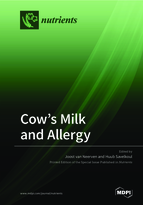Cow's Milk and Allergy
A special issue of Nutrients (ISSN 2072-6643).
Deadline for manuscript submissions: closed (15 May 2019) | Viewed by 109962
Special Issue Editors
Interests: mucosal immunology; allergy; asthma; food allergy; nutrition; dairy
Special Issues, Collections and Topics in MDPI journals
Interests: the regulation of IgE antibody formation in allergy, the immunogenicity and allergenicity of dietary components, the basic immune-mediated mechanisms in food allergy, the immunomodulation by food and feed, and the development of allergy-linked immunodiagnostics
Special Issues, Collections and Topics in MDPI journals
Special Issue Information
Dear Colleagues,
The purpose of this Special Issue “Cow’s Milk and Allergy” is to provide an overview of the association of cow’s milk with allergy. This topic has two quite different faces. On the one hand, we are all aware of the importance of cow’s milk allergy in early life. What is less known is that the consumption of raw, unprocessed milk is associated with a lower incidence of asthma and rhinitis. In this Special Issue, we want to take a closer look at all of these aspects of cow’s milk and allergy and focus on the following questions:
- Mechanisms of cow’s milk allergy
- Epidemiology of cow’s milk allergy
- Prevention of cow’s milk allergy
- Immunotherapy of cow’s milk allergy
- Milk processing, baked milk, and cow’s milk allergy
- The consumption of raw milk and inhalation allergies
We hope that by focusing on these topics, the Special Issue will create a broad, yet concise, overview of how cow’s milk is associated with allergy.
Prof. RJ Joost van Neerven
Prof. Huub Savelkoul
Guest Editors
Manuscript Submission Information
Manuscripts should be submitted online at www.mdpi.com by registering and logging in to this website. Once you are registered, click here to go to the submission form. Manuscripts can be submitted until the deadline. All submissions that pass pre-check are peer-reviewed. Accepted papers will be published continuously in the journal (as soon as accepted) and will be listed together on the special issue website. Research articles, review articles as well as short communications are invited. For planned papers, a title and short abstract (about 100 words) can be sent to the Editorial Office for announcement on this website.
Submitted manuscripts should not have been published previously, nor be under consideration for publication elsewhere (except conference proceedings papers). All manuscripts are thoroughly refereed through a single-blind peer-review process. A guide for authors and other relevant information for submission of manuscripts is available on the Instructions for Authors page. Nutrients is an international peer-reviewed open access semimonthly journal published by MDPI.
Please visit the Instructions for Authors page before submitting a manuscript. The Article Processing Charge (APC) for publication in this open access journal is 2900 CHF (Swiss Francs). Submitted papers should be well formatted and use good English. Authors may use MDPI's English editing service prior to publication or during author revisions.
Keywords
- cow’s milk allergy
- prevention
- hydrolysate
- processing
- raw milk
- epidemiology
- immunotherapy








